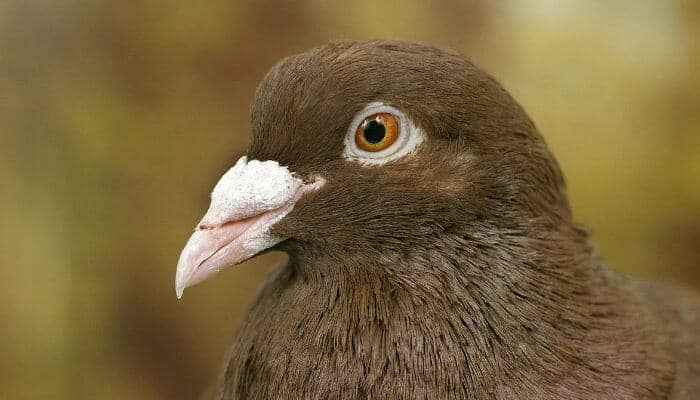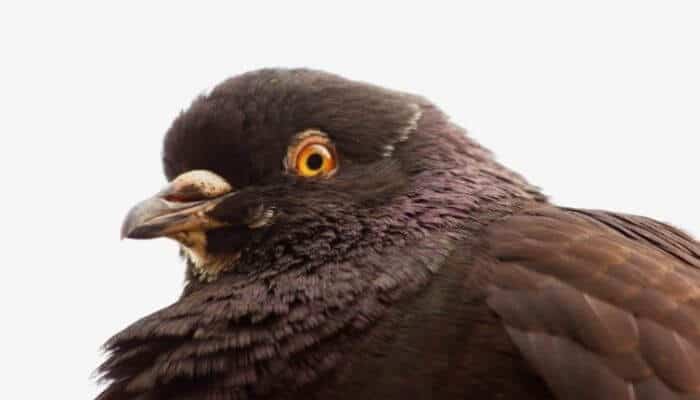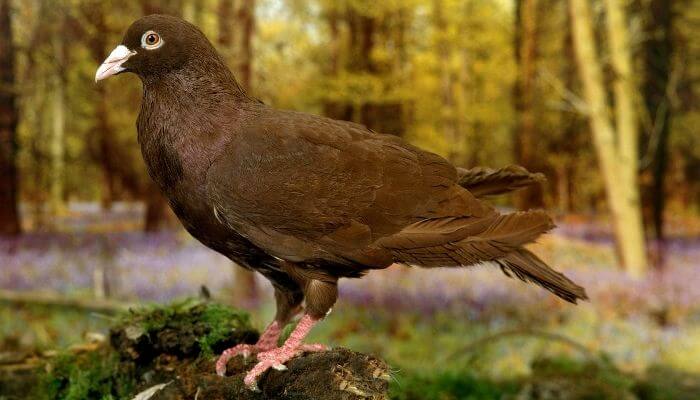The Carneau pigeon is a fancy utility pigeon developed through many years of selective breeding. It is known for its large size and suitability for squab production.

The Carneau pigeon might not be one that you are very familiar with, but the breed has played some interesting roles in history over the decades.
Origins of the Carneau Pigeon
Many times, it is impossible to put a breeder’s name to a type of pigeon that is the result of selective breeding, especially older breeds as records were either incomplete or have been lost.
With the Carneau though, there is some credible history.
Back in 1992 in Northern France, the Fontaine Family was very important in pigeon breeding circles.

Although it isn’t clear if the Fontaines were directly involved in creating the breed, they did document that the Carneau was the result of crossing a mondain pigeon with a rock dove (common pigeon).
The French mondain was a large ancient breed originally raised for meat production.
Distribution And Habitat of the Carneau Pigeon
Early iterations of the Carneau pigeon were once free-flying birds, but as the process of selective breeding took over and the birds became heavier and more domesticated, the notion of a natural habitat for the breed became less relevant.
Now, as fancy pigeons that are primarily bred in captivity, Carneau pigeons generally thrive in well maintained domestic habitats.
The carneau has remained a popular pigeon in Northern France and Southern Belgium. The Carneau Club Francais was formed in 1933 and in 2015, at the European Show in Metz, 243 carneau pigeons were entered (by breeders from three countries).
It was also popular in other countries in the early 20th century as there was an International Carneau Club. The club produced its own book, The Carneau Pigeon published in 1910.
The breed spread to the USA and there is the American Carneau Association for breeders and owners. It may have been popular in the UK in the early years, but there is no modern breeders club for this breed.
Carneau Pigeon Appearance

The standard carneau is a large-sized and heavyweight bird with a slightly upright stance.
The carneau is the second largest domestic breed of pigeon after the King Pigeon.
| Wingspan | Length | Weight | Coloring | |
|---|---|---|---|---|
| Carneau Pigeon | 60 – 70 cm | 32 – 35 cm | 640 – 740 g | Red, yellow or white Or Red, yellow or white with specific markings |
| Average Feral Pigeon | 64 – 72 cm | 32 – 37cm | 300 – 500 g | Bluish grey with some black. |
No longer bred for meat, the carneau is now raised for it beauty as an exhibition bird.
Breeders pay particular attention to color. Among other colors, it is one of the relatively few number of breeds of white pigeon.
Breed standards for color are quite specific. Carneau pigeons can be
- Red, yellow or white
- Red or yellow with a white wing rose
- Red or yellow with a white lower back
- Red or yellow with a white wing rose and white lower back
- They may also appear to be entirely reddish/brown.
Colors should be deep and rich with closely formed plumage to create an intensive sheen.
The skin of a Carneau is pink and unusually, the feather shafts are also colored.
This pigeon has a noble head that is broad and gradually slopes down to the nape of the strong, thick neck. The beak is typical of a pigeon – short, stout and of a medium length.
Carneau pigeons have very prominent eyes, very round and bright with colors that will vary depending on the overall coloring of the bird. Cere are small, smooth and flesh-colored.
The body of the Carneau is solid, broad but compact and wedge-shaped with a prominent breast. The bird stands on straight legs that are set well apart, red in color and feather-free.
Wings are quite long and the wedge-shaped tail extends about 1 inch longer than the main flight feathers.
You can expect a healthy Carneau pigeon to have a lifespan of anywhere between 7 and 10 years.
Carneau Pigeon Character
Carneau pigeons are known for is having an excellent temperament, second only to the King Pigeon which is widely regarded as being the most placid breed of all. They can be very curious birds, and if kept as house pets will often need an eye to be kept on them as they ‘explore’!
The Carneau pigeon has such a good temperament, in fact, that it was used extensively in historical experiments regarding operant conditioning.
The majority of the pigeons used in B. F. Skinner’s famous work on schedules of reinforcement were actually white Carneau pigeons.
Diet of a Carneau Pigeon
Like the vast majority of the 300+ breeds, the Carneau diet is typical of what a pigeon eats. Owners can pretty much choose the best pigeon food for their birds.
They might also add supplementary food items such as fruit, nuts, berries, and mealworms to ensure they are providing all the vitamins a pigeon needs.
Carneau Pigeon Mating and Breeding
Being a domesticated fancy pigeon, the mating and breeding of the Carneau pigeon is controlled and dictated by the owners and breeders.
To enhance the standard of the breed, mating pairs will be chosen based on particular desirable traits and characteristics that they have, and this will be to do with size, coloring, and general good health.
The aim of breeding Carneau pigeons domestically is to continue the breed line with the best possible physical traits in mind.
Taking Care of Carneau Pigeons
The care of a Carneau pigeon is low maintenance compared to some other more demanding breeds.
Their large size thanks to selective breeding means that they do not have the talent for flying like they used to, so a traditional domestic habitat that is clean and comfortable will be more than enough to house a Carneau pigeon happily and without concern.
It is a sociable breed and is happy to interact with other breeds and also humans so are just as lovely to raise as pets as for exhibiting.
